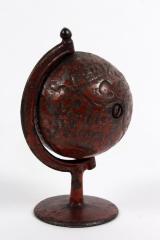Comments and Tags
Be the first to comment on this item!
Toys and Games ➔ Toy Bank, Chinese Man In Boat
Identifier:
90495Description:
This toy bank, created in 1880, is the embodiment of the frustration many Americans felt about the large influx of Chinese immigrants arriving on the West Coast. Through this bank, Chinese immigrants were portrayed to the American populace as dim witted and uncultured peoples who were stealing American jobs by becoming sources of cheap labor. The words, "Cheap Labor/Hotel/Dinner/One Cent In Advance," emblazed on the boat's dinner table makes the man on board seem illiterate and desperate.Date:
1880Materials:
Cast IronDimensions:
4.5in" h 7.25in" w 3in" dCurrent Location Status:
In StorageCollection Tier:
Tier 2Source:
Gift Of Babbitt, Florence S.Links:
http://archives.lib.uconn.edu/islandora/object/20002:860115765Related Entities:
Florence S. Babbitt (donor)Florence Babbitt was born on March 19, 1847 in New York and was an antique collector and well known dealer with antiques in the state of Michigan. She helped Henry Ford with his museum as well as donating collections to all major museums in the state. As well as being a well known dealer with antiques and a collector, she was also a part of many associations in which she was often elected the president of. These include the Women's Relief Corp and the Eastern Star, as well as the DAR, The Chaplin Family Association, The Willard Family association, and had connections with the Lewis Family Association. She married Judge John Willard Babbitt and had 5 daughters and 1 son. She passed away at 82 on November 3, 1929.
J and E Stevens Company (creator)"The J. & E. Stevens Company was formed in Cromwell, Connecticut, in 1843 when John and Elisha Stevens established a factory to manufacture cast iron hardware, hammers and simple iron toys. In 1859 it produced its first fire cracker pistol and by the mid-1860s the company focused almost exclusively on the production of toys. In 1869 the company produced its first cast iron mechanical bank and it was soon nationally known for its innovative designs of mechanical banks, as well as still banks, or the traditional "piggy" banks cast of metal in the shape of animals, buildings, or other figures, with a slot to insert the coins. The company produced a great many other types of toys, including toys stoves and cannons, but by 1928 it devoted itself exclusively to the production of cap pistols.
During World War II the company closed due to the shortage of iron and the company was sold to Buckley Brothers of New York in 1950." (University of Conneticut Website)

